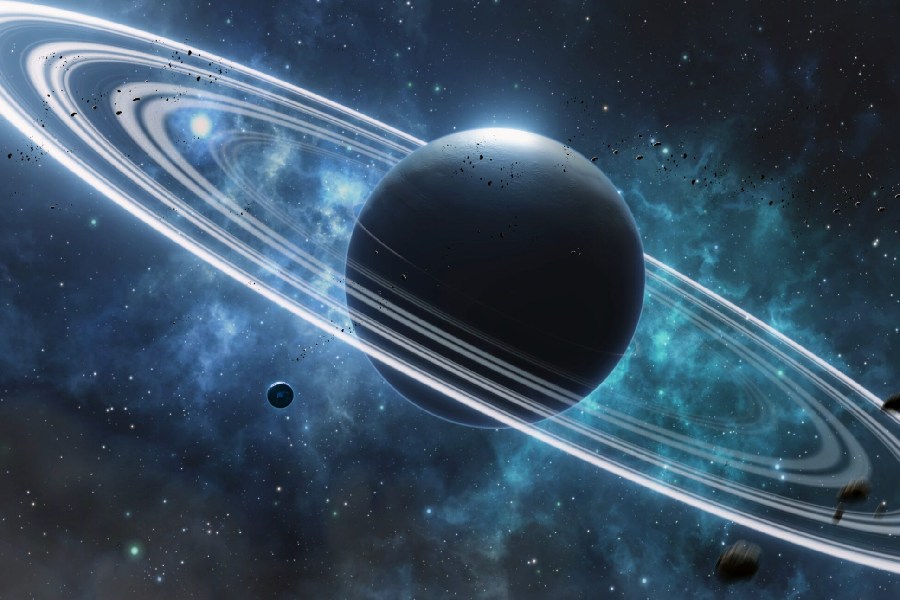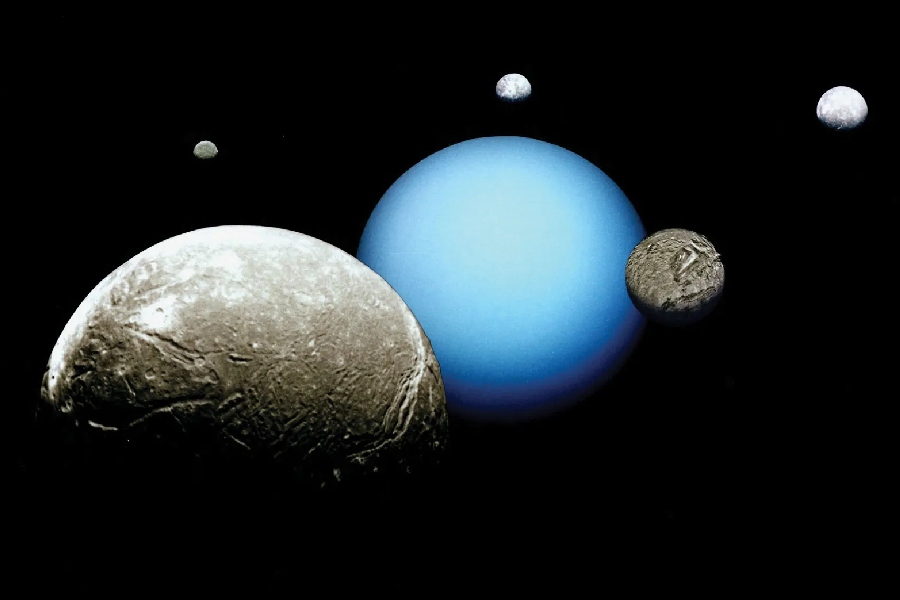In the icy outskirts of the solar system lurks a puzzling blue orb—the planet Uranus. At over 19 times further than Earth’s distance from the Sun, this ethereal giant has intrigued stargazers for decades with both its bizarre 98° tilt and the coterie of diverse moons in constant motion around it. Unlike the planet we live on, Uranus has more than one moon. But how many moons does Uranus have, exactly?
This distant ice giant plays host to a surprisingly diverse array of orbiting satellites that have captivated astronomical curiosity.
From the known major moons that carve their orbits to the elusive moonlets that may hide in plain sight, we uncover the secrets held by each of these cosmic companions.
As we delve into the origins, characteristics, and peculiarities of Uranus’ moons, the answers may unveil not only the planet’s history but also the intricate dance of gravitational forces shaping our distant neighbor.
Join us in exploring Uranus’ lunar mysteries, where new discoveries await as we seek to understand this celestial collection orbiting an icy giant.

How Many Moons Does Uranus Have?
Uranus has 27 known moons as of the latest information available. These moons are diverse in size, composition, and orbital characteristics. The largest major moons of Uranus are Titania, Oberon, Umbriel, Ariel, and Miranda.
These major moons were discovered by the Voyager 2 spacecraft during its flyby in 1986. In addition to the major moons, there are numerous smaller (or also referred to as minor) moons and moonlets, some of which were discovered more recently through telescope observations and advanced imaging techniques.
The Majestic Five: Uranus’ Major Moons
Titania: Uranus’ largest moon
Titania is the largest of Uranus’ five major moons at over 800 miles wide and the 8th largest moon in our solar system. This distant icy world has a mysterious fractured surface that hints at a complex geological past filled with internal activity.
Titania’s terrain consists of everything from craters to canyons over a mile deep, illustrating the moon’s stormy history.
One unique feature is the giant Messina Chasmata canyon system – likely created by internal processes extending the moon’s crust. Though frigid and far from the Sun, Titania still displays signs of a once-active world.
Oberon: a moon of mysteries
While slightly smaller than Titania at just over 700 miles in diameter, Oberon ranks as Uranus’ second largest moon and the 9th largest overall in our solar system.
Oberon possesses one of the most strikingly peculiar surfaces glimpsed in the outer solar system. It is saturated with craters, grooves, and cliffs towering over 11 kilometers high!
This bizarre landscape points to major resurfacing events in Oberon’s distant past. The original causes for why this moon was so heavily resurfaced still remain unknown.
One theory speculates Oberon may have orbital debris strike its surface more frequently due to gravitational resonance effects with Uranus’ tilted magnetic field. For now, the moon’s mysterious terrain offers more cosmic questions than answers.
Umbriel, Ariel, and Miranda: the enigmatic trio
While smaller than Titania and Oberon, these remaining three moons each hold unique surprises unveiled by passing spacecraft. Darkest of the group, the ancient, crater-riddled surface of Umbriel hints at past melting from major impacts.
Ariel has an extensive canyon system across parts of its frozen surface. That’s likely created by internal tensions as past shifts altered orbital motion over time. Tiny Miranda sports jumbled landscapes that clash together in bewildering fashion – evidence of a catastrophic shattering long ago now frozen in time.
Though often overlooked beside the two larger moons, this trio of enigmatic orbs each tells a compelling story for those willing to listen.

Moonlets and Minor Moons
While the five largest draw the most attention, Uranus plays host to a diverse array of over two dozen smaller, eccentric satellites. The majority remain shrouded in mystery – mere faint specks glimpsed briefly during spacecraft flybys. Racing orbits tilted sharply from the equatorial plane illustrate these moons’ captured origins – likely wayward asteroids or debris scattered outward during ancient collisions.
Though dwarfed by flashy like Miranda or Ariel, each mini-moon still orbits faithfully around its distant blue lord after billions of years. What stories might these unexplored worlds tell if studied more closely?
Recent discoveries
Until recently, 27 moons represented the full known family. But new technology has led astronomers to confirm more tiny members than previously detectable. Moonlets as small as just 2 miles in diameter have only been found circling Uranus in the past few years, exploiting advanced optics and imaging.
Understanding the scale becomes clear, realizing Earth’s moon is over 2000 times more massive than these diminutive specks! Yet their abundance inspires questions about just how populated the realm around ice giant planets may be and whether even tinier objects await future discovery.
Irregular Moons
Irregular moons are smaller satellites with more distant, inclined, and eccentric orbits than a planet’s regular moons. Uranus has nine confirmed irregular satellites orbiting at steep angles, hinting at captured asteroids or debris instead of moons formed from the planet itself.
A few known examples are Cordelia, Ophelia, Cressida, and Desdemona – all tiny worlds less than 20 miles wide first spotted in images from the Voyager 2’s 1986 flyby. The orbits of these diminutive, irregular moons illustrate their outsider origins compared to Uranus’ orderly equatorial satellites.
Cordelia races the farthest from its planet in a tight two-year orbit, while Desdemona loops extremely inclined over 64 degrees askew from the planet’s equator and rotational axis. Each offers clues into Uranus’ gravitational reach and the cosmic flotsam drawn into its realm over eons.
Portia, Rosalind, Belinda and Perdita
In addition to the first irregular moons confirmed from Voyager 2 imagery, astronomers using advanced optics like the Hubble Space Telescope uncovered four more tiny irregular satellites orbiting Uranus in the past couple of decades – Portia, Rosalind, Belinda, and Perdita.
Little larger than 10 miles wide, these four minuscule worlds hint that many smaller bodies likely orbit undetected and await discovery around ice giants like Uranus and Neptune.
Dark Moons
Unlike the icy bright surfaces we associate with moons, Caliban and Stephano represent a mysterious class known as Uranus’ “dark moons.” Rather than reflecting much visible light, these two small irregular satellites, only about 30 miles wide, have extremely dark gray surfaces that absorb over 85% of light shining on them.
This darkness intrigues astronomers and adds to the questions orbiting both little worlds since their discoveries in the late 1990s. Leading theories speculate that past impacts likely blasted away lighter outer ice layers on Caliban and Stephano, exposing darker underlying material.
Comet fragments or captured centaur objects that migrated from the Kuiper belt may supply this carbon-rich debris that coats their exteriors.
Of Uranus’ 27 known moons, these two absorbed oddities stand out as the darkest by far. Further study would help shed light on their pasts – especially if an orbiter could analyze their surfaces to reveal chemical composition.
Until a dedicated mission travels back to the icy giant planet, however, Caliban and Stephano remain cloaked in darkness and mystery, unlike any other Uranian moons.
Conclusion
And thus, we come to an end of our journey investigating the unique array of worlds orbiting around frigid Uranus. We hope you have gained a deeper insight into how many moons Uranus has and the remarkable diversity displayed amongst its orbiting satellites– from the frozen majesty of Titania to elusive moonlets only recently revealed.
As we have explored, Uranus boasts 27 confirmed moons as of 2023, with many others likely awaiting discovery as observational technology advances. This distant realm offers endless intrigue for astronomers and enthusiasts alike.
In conclusion, understanding the complexity orbiting the icy giant planets broadens our understanding of the Solar System’s wonder – and the collection of marvels still waiting to be learned in worlds beyond our sight.
